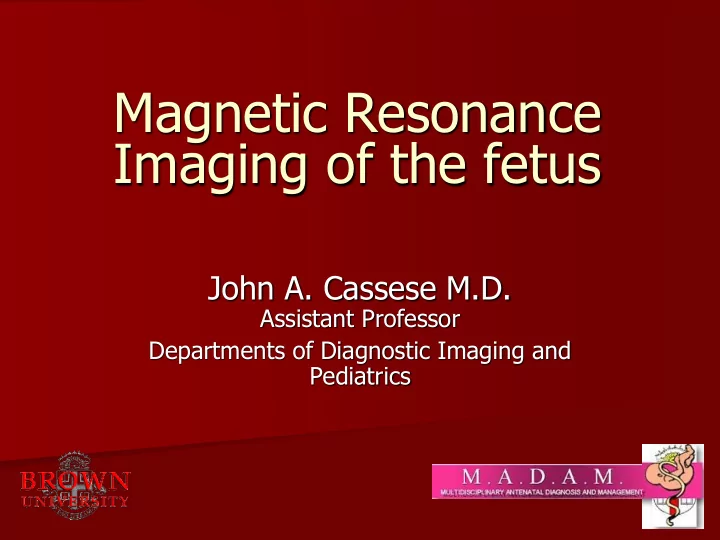

Magnetic Resonance Imaging of the fetus John A. Cassese M.D. Assistant Professor Departments of Diagnostic Imaging and Pediatrics
MR as an Imaging Tool Nuclear Magnetic Resonance Spectroscopy – Known for a long time in the chemistry lab • Idea of Medical Imaging arose in 1980 ’ s
Basic Principals of MRI How does Magnetic Resonance Imaging work? – Certain nuclei act like tiny magnets 1 H imaging – By using a large external magnetic field and radio waves -manipulate magnetic properties to determine relative concentration and position of 1 H within tissue
Basic Principals of MRI Strong magnetic field – 0.3 -> 3 Tesla 1 Tesla = 10,000 Gauss Earth ’ s magnetic field 0.3 - 0.7 Gauss Refrigerator magnet 100 Gauss – Aligns protons with field creating strong vector
Basic Principals of MRI Superimposed a variable magnetic field (gradient) Introduce energy (radio waves) – Frequency just below FM radio Some protons absorb energy Turn off radio waves and listen for return frequency as proton release energy (relaxation time)
Basic Principals of MRI Two separate characteristics of protons that are recorded (T1 and T2) Numerous applications (sequences) to enhance and display differences in these characteristics First clinical applications 1980
Magnetic Resonance Fetal Imaging Then- first described in 1983 – Conventional spin echo technique – Required maternal and/or fetal sedation Now- advances in hardware/software allow an image to be obtained in milliseconds – Effectively freezing fetal motion
MR Fetal Imaging- T2 Sequences – Single shot fast spin echo (SSFSE) – HASTE half-Fourier single-shot turbo spin echo – Imaging blurring – High RF deposition- heating – Low SNR Workhorse – anatomy
MR Fetal Imaging- T1 Sequences – FLASH fast low angle shot Relatively slow (20 sec) without high performance gradients Hemorrhage Calcification Lipomas
MR Fetal Imaging- Diffusion Weighted Imaging Sequences – Distinction between water moving freely or in a restricted way Hypoxic-ischemic injury
MR Fetal Imaging- Timing of exam Late 2 nd trimester onward Avoid first trimester- effects not studied
MR Fetal Imaging- Adjunct to US Ultrasound remains the primary screening modality – But may be limited by Reverberation artifact Poor penetration through the ossified skull Oligohydramnios Fetal position- particularly in late pregnancy Nonspecific appearance of certain abnormalities
MR Fetal Imaging- Advantages Superior contrast resolution Better visualization of CNS structures Large field of view True multiplanar imaging Non-ionizing radiation
MR Fetal Imaging- Adjunct to US Confirm diagnosis/offer alternative diagnosis Identify additional abnormalities Patient counseling/pregnancy management Problem solver
MR Fetal Imaging- Indications CNS abnormality Neck/Chest/Abdominal Mass Lung hypoplasia Renal/GU abnormality Spine/Sacrococcygeal teratoma
MR Fetal Imaging- CNS Fetal MRI of the CNS is particularly helpful – Etiology of ventriculomegly – Evaluation of posterior fossa collections – Evaluation of mylination/migration abnormalities – Documentation/extent of hemorrhage or ischemia
MR Fetal Imaging- CNS Levine D, et al. obstet gynecol 1999; 28:169-74 – MRI lead to a change in diagnosis 26/44 (40%) Twickler D, et al. Am J Obstet Gynecol 2003; 188:492-6 – Additional information 64% – Change in diagnosis 28% – Alter timing/mode of delivery 11%
23 wk 17 wk 33 wk term
Aquaductal Stenosis
Hydranencephaly
Dandy Walker Malformation
Arachnoid Cyst
MR Fetal Imaging- Non CNS Airway/ thoracic abnormalities – Obstructing neck mass – Lung Hypoplasia – CDH: document position of the fetal liver Liver “ up ” vs. “ down ” ; mortality 57% vs. 7% – Chest masses CCAM Sequestration Bronchogenic cyst
MR Fetal Imaging- Non CNS Fetal lung hypoplasia – Lung volume Vs. Gestational age Vs. Fetal size Vs. predicted volume – Signal intensity
MR Fetal Imaging- Lung Hypoplasia Low-intensity fetal lungs on MRI may suggest the diagnosis of pulmonary hypoplasia Shigeko Kuwashima, et al. ( Pediatr Radiol . 2001;31:669-672.) • Concept of lung-to-liver intensity ratio • Value <2 suggests hypoplasia in fetuses after 26 weeks
Lung= 90 Liver=91 Ratio=0.99
Achondroplasia coronal chest anterior to posterior
coronal chest anterior to posterior cont.
axial chest with grossly normal signal intensity within the lungs
Congenital Diaphragmatic Hernia
MR Fetal Imaging- Non CNS Airway/ thoracic abnormalities – Obstructing neck mass – Lung Hypoplasia CDH: document position of the fetal liver – Liver “ up ” vs. “ down ” ; mortality 57% vs. 7% Chest masses – CCAM – Sequestration – Bronchogenic cyst – Chest Wall
MR Fetal Imaging- Non CNS Abdominal masses GI/GU anomalies Sacrococcygeal teratoma TTTS
Renal dysgenesis oligohydramniosis
Twin-To-Twin Transfusion Syndrome
MR fetal Imaging- Cutting Edge Evaluation of the placenta Ungated fetal cardiac cine – Echoplanar imaging Assessment of nutritional status by evaluation of adipose tissue
MR fetal Imaging- Cutting Edge Functional MR – 33+ weeks – Brain oxygenation MR spectroscopy – Lactate in Brain – Myelin in Brain – Lecithin in amniotic fluid and/or lung parencyma lung maturity
MR Fetal Imaging- Conclusions Useful Adjunct to ultrasound – Any CNS anomaly – Any chest mass Problem solver – Abdominal/pelvic lesions Surgical planning
Recommend
More recommend